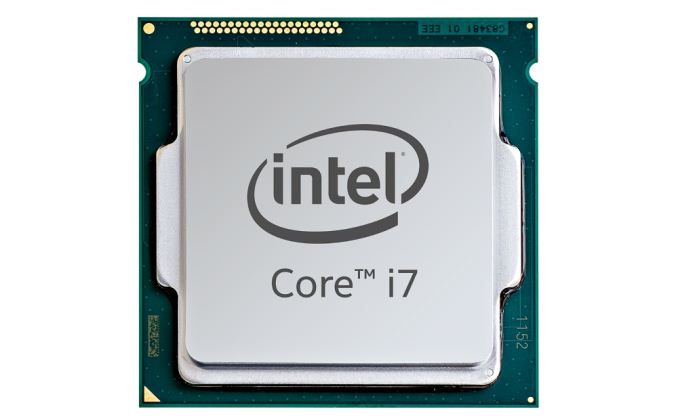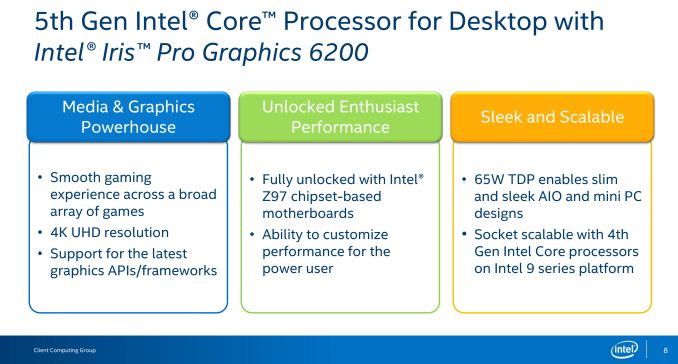The Intel Broadwell Desktop Review: Core i7-5775C and Core i5-5675C Tested (Part 1)
by Ian Cutress on June 2, 2015 7:45 AM ESTBroadwell-DT: Initial Thoughts
The new Broadwell desktop processors are somewhat out of sync with our regular expectations from Intel. Due to issues surrounding the 14nm node, as well as the cost, the whole Broadwell line from tablet to table-top has come out slower and more staggered than any Intel release in recent memory. As a result, the initial launch from Intel today is a pair of 65W desktop socketed models backed up with three 65W soldered down models whose true heritage is a chip primarily designed for large laptops and all-in-one devices.
Normally we would expect a range of desktop models from 35W up to 88W or higher, but socketed Broadwell-DT today only exhibits two units at 65W. This immediately puts a slight damper on those expecting to upgrade from Haswell’s high-end, or those wanting to go from something like a Pentium G3258 on Haswell to Broadwell’s top SKU. As a result, we have to keep our expectations in check – 65W should on paper perform nearly as well as an 88W part would, except it would be reduced by several hundred MHz. Meanwhile as these processors are also fully-unlocked and overclockable, we're left to ponder whether or not the stock frequencies actually matter in that case.
Due to the differential tangent at play, these processors also exhibit Intel’s best integrated graphics package, Iris Pro (GT3e), previously reserved only for soldered down/laptop/mini-PC orientations. This graphics package comes with largest number of execution units available from Intel, 48, alongside 128MB of eDRAM that acts almost like an L4 cache. This helps alleviate memory bandwidth pressure by providing a large(ish) pool near the CPU but with lower latency and much greater bandwidth than main memory. The eDRAM has the greatest effect in graphics, but we also saw some moderate increases in our non-3D regular benchmark suite.
The benefit of the graphics package, Iris Pro 6200, means that Broadwell-DT takes the crown as the fastest socketed graphics available. Our testing showed that the even the second-tier socketed SKU, the i5-5675C, outgunned the previous title holder, AMD’s A10-7870K. Despite having the i7-5775C in to test, due to time and firmware issues, we were unable to run the numbers on the integrated graphics but will do so in a later piece.
The key element to Broadwell-DT is not to consider it a natural successor to Haswell. It doesn't so much replace Haswell-K at this time, so much as it occupies a space Intel has left neglected since the launch of Haswell – the ultimate Intel integrated graphics solution. For users on integrated graphics, where money is no object, Intel now offers you the option to combine the regular CPU performance associated with Intel and a GPU that has the added performance benefits of on-chip, high-bandwidth eDRAM. The only question is whether that combined performance is worth the potential cost, and some would say no, pointing at a combined APU + GPU solution for equivalent or better gaming performance for the same price.
Pricing for the i5-5675C is listed as $276, slightly higher than the price of the i5-4690K which is at $236 on Amazon (reduced from $265). The i7-5775C is a bit higher at $366, also a margin higher than the i7-4790K which is $339 (reduced from $380). This makes Broadwell a tough sell right now in most circumstances unless you are absolutely limited to integrated graphics and want the best solution possible in a configurable PC. Given that Intel has also mentioned Skylake in their recent Computex keynote, it implements an abnormal situation that Intel has never been in with a new platform being talked about in the same breath. We have been told that these parts exist because users wanted them, and it has been interesting to see just how the added eDRAM changes the performance with discrete graphics in the mix.












196 Comments
View All Comments
mgilbert - Tuesday, June 2, 2015 - link
Less heat and less noise is nice. More FPS is better. When someone can build a silent system that can keep up with an i7 processor and GTX 970 video card, let me know. In the meantime, I won't compromise. Some fan noise is a small price to pay for a more immersive and detailed gaming experience. Just put on your headphones.Gigaplex - Tuesday, June 2, 2015 - link
Why i7? The i5 is just as good when it comes to games, since hyperthreading doesn't do much for games.hero4hire - Thursday, June 4, 2015 - link
We call those laptops. Passively cooled? That's normal htpc and abnormal niche PC user/gamerRefuge - Tuesday, June 2, 2015 - link
100 watts is less than $80 usually a year if it is only when you are gaming. Just say no to ordering lunch like 3 days a year and you are good. :)FlushedBubblyJock - Friday, June 12, 2015 - link
When AMD inefficiency costs an $80 bill, skip lunch it's all good...When an Intel or nVidia product is $8 more let alone $80, that settles the whole matter completely in AMD's favor, and proves once again AMD is the best bang for the buck....
That's how AMD fanboys play it.
I guess despite all the sickening propaganda of the amd fans, no one is listening nor buying it.
AMD is dying and nearly dead, market share and share prices...
What the AMD fanboys forgot is no one else likes being lied to, nor told what to do.
Hulk - Tuesday, June 2, 2015 - link
I don't care about small differences in power consumption for home use either. But I do like the info to compare nodes.Iketh - Tuesday, June 2, 2015 - link
as a gamer in florida, I care very much... gaming in the summer the heat produced is enormous and the central A/C is running overtime trying to keep temps downDPUser - Thursday, June 4, 2015 - link
Go Solar!Iketh - Tuesday, June 2, 2015 - link
+1Novacius - Tuesday, June 2, 2015 - link
They could put 8 cores in there instead of that GPU.